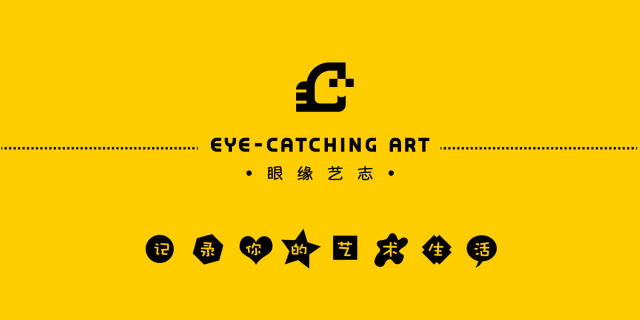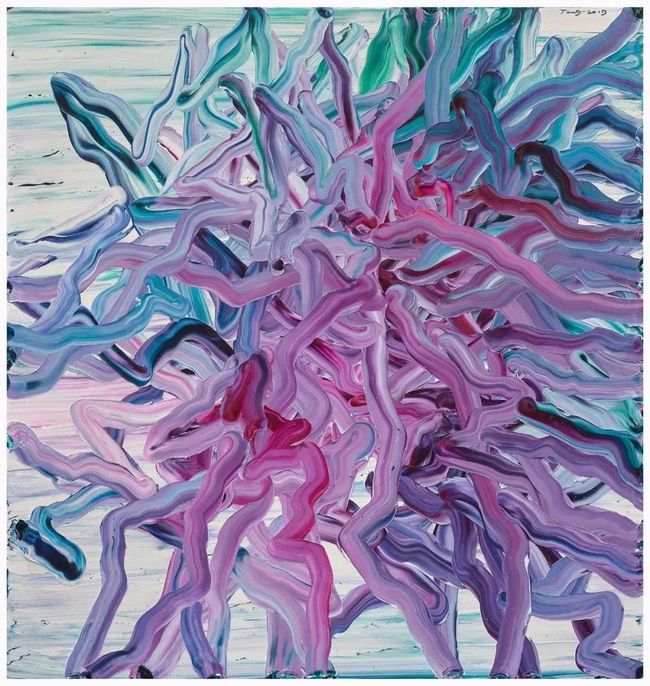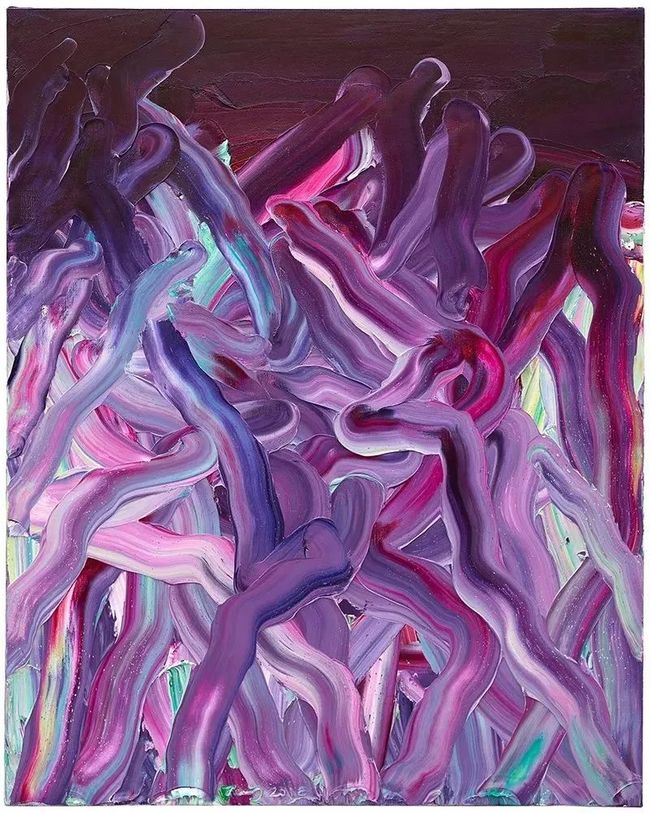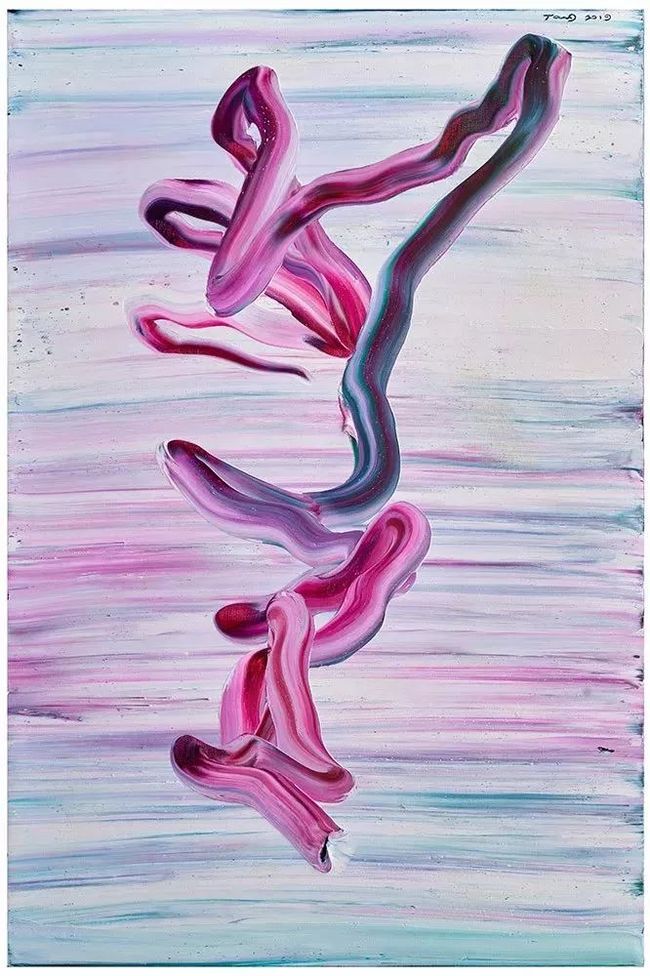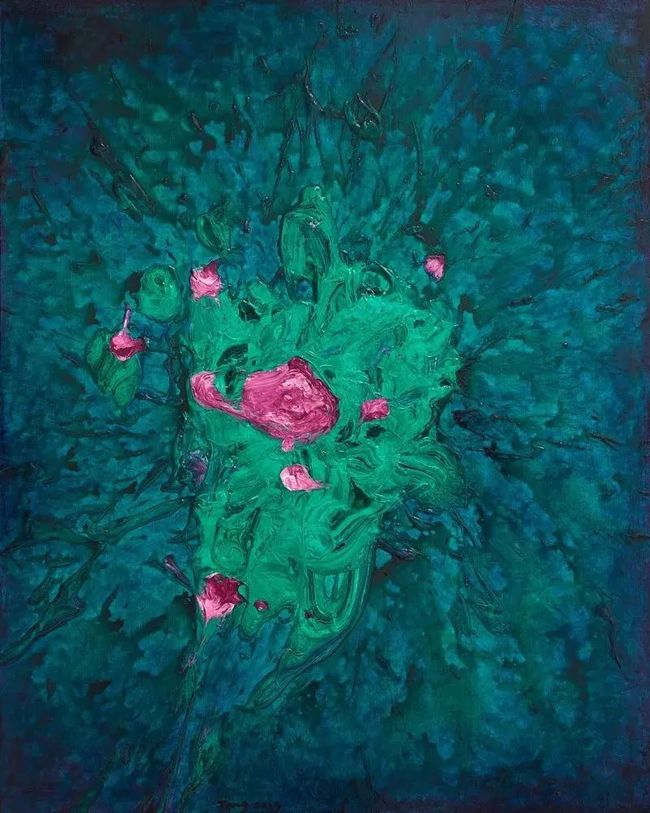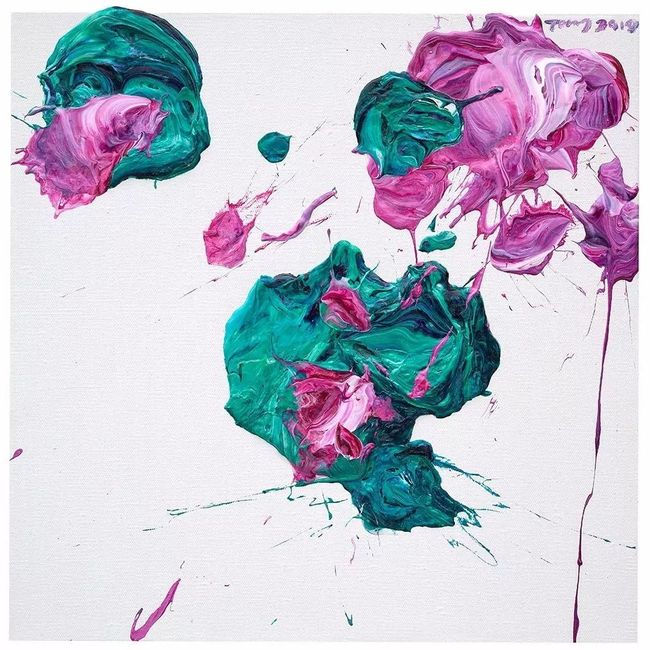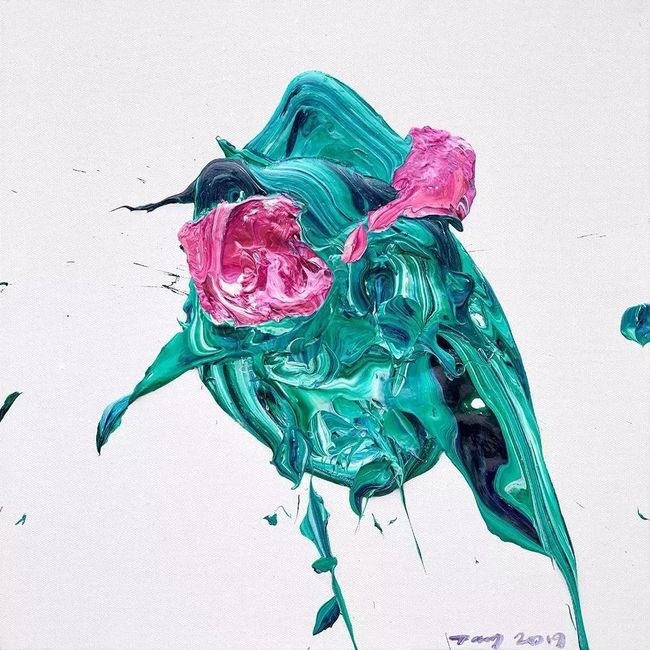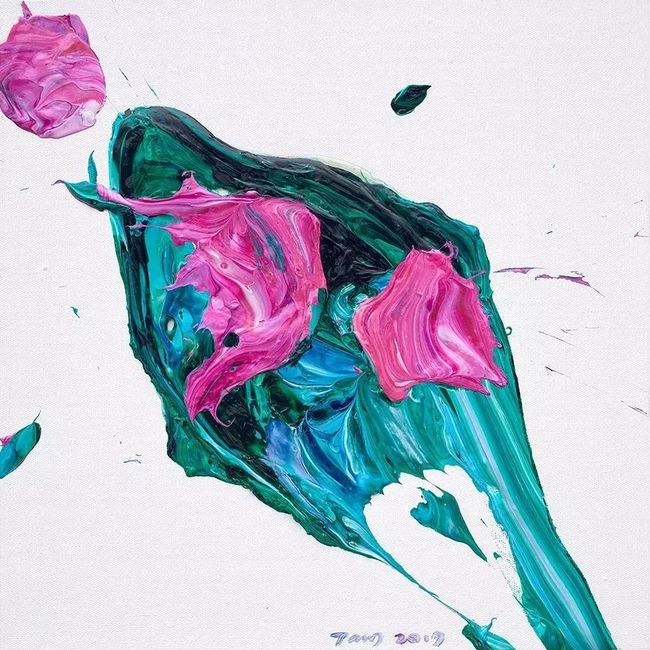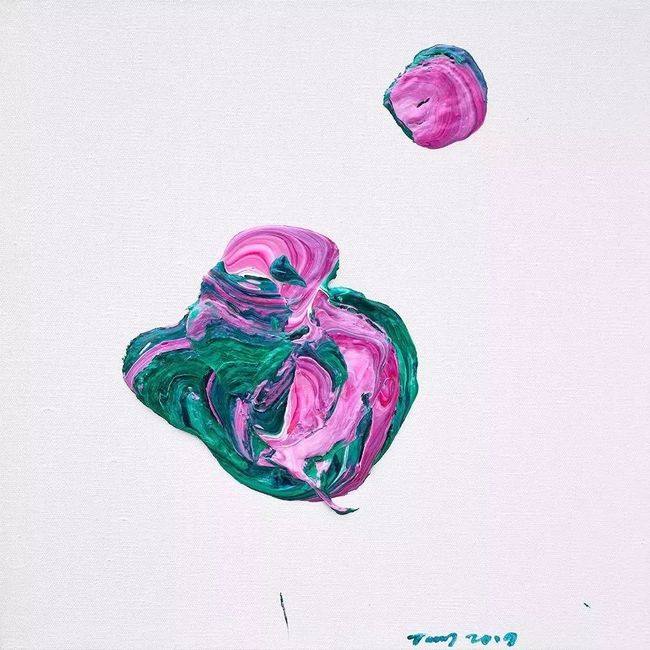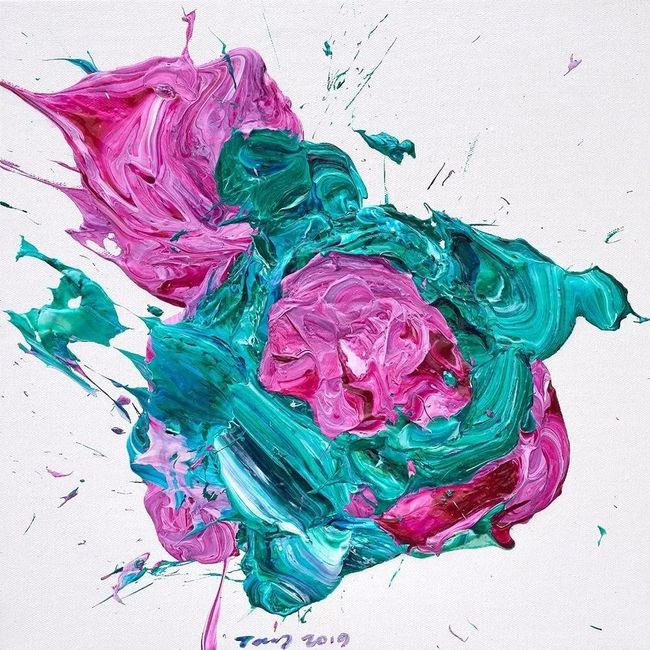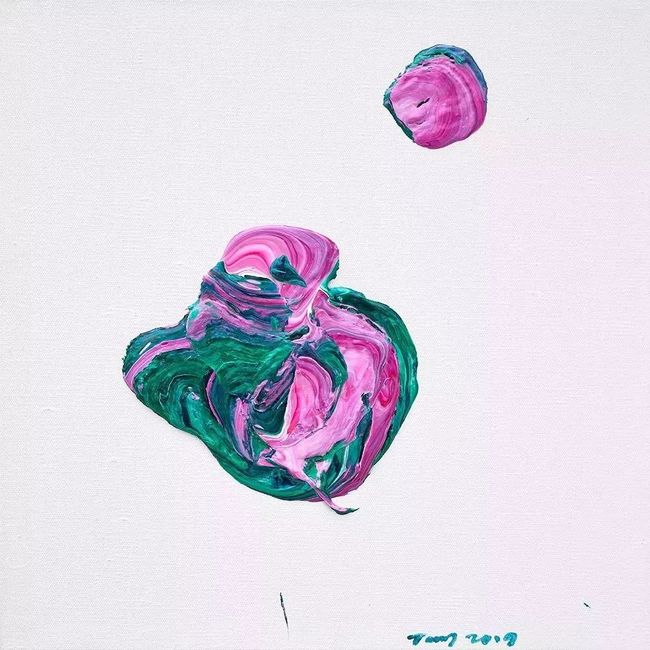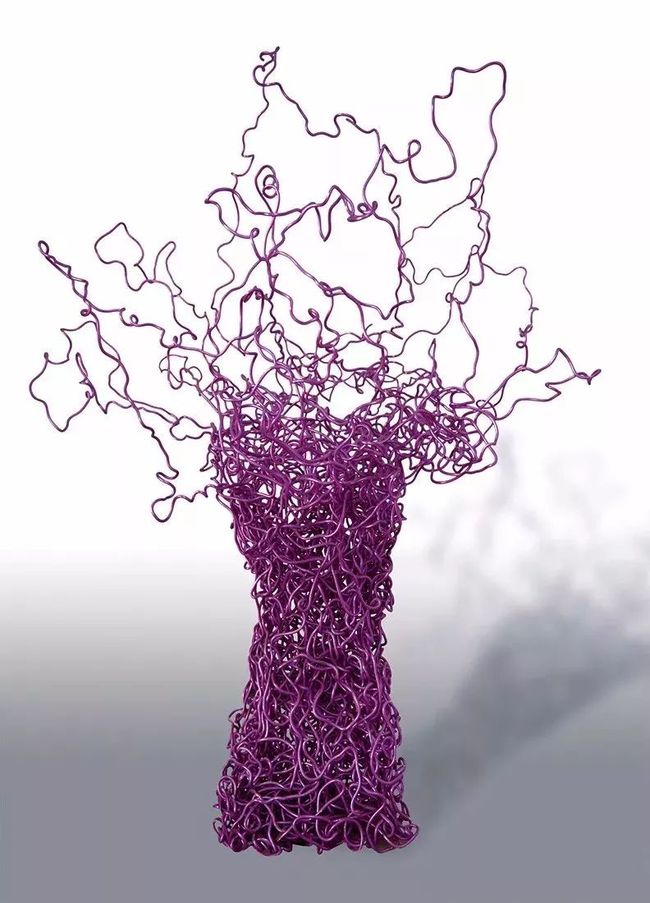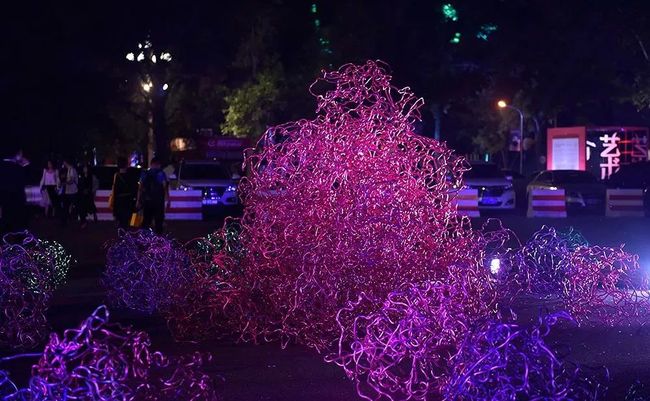在前几期的GM-艺术北京年度特辑中,我们带大家欣赏到了唐华伟老师的作品,相信有很多人都是很喜欢唐老师的,所以本期的目光再次聚焦,专门开设一期关于唐老师此次参展作品的详尽介绍。
本期展览的主题是立夏,唐老师用抽象的方式表达着自身的生命体验、理性思考以及内心深处激荡的情感。在视觉的冲击下接受着心灵上的洗礼,直面作品中的恢弘与力量。
线与像
画面中纠结的线,发着幽光
这些微弱的光,和从未放下的好奇心
牵引着我,在黑夜里,蹒跚而行
深一脚浅一脚
间或跌倒了又爬起来
拍拍尘土,继续前行
不经意间,愈走愈远……
等我登上横亘在东西方文明的山丘
回头张望:苍穹之下
那些跌宕起伏的线
以及粗粝的油彩
交织在一起
原来
就是我的自画像
——唐华伟
Lines and Images
Entangling lines in my paintings,
there can be light in darkness.
Those and my eternal curiosity,
guides me to limp along in the dark night.
I stagger in a zigzag, occasionally,
climb up after falling down,
patting the dust and keep on moving.
Unconsciously,
when I top the mountains,
lying across western and eastern culture,
I turn back and look around.
Under heaven,
those fluctuating lines and harsh oil paintings,
intertwine together.
So that accounts for my self-portrait.
——Tang Huawei
作品阐述 | Artworks Elaboration
唐华伟的绘画,是用抽象方式表达自身的生命体验、理性思考以及内心深处激荡的情感。他的作品,线条动感,饱含能量;色彩感性甚或性感,厚如浮雕;画面质地宛若鲜活的肌体蕴藏着勃勃生机。同时,他独特的绘画语言来自于他将中国书法的文化传统创造性地融入到以西方文化为背景的油画语言中,使粘稠的油彩在画布上自由生成具有东方意味的视觉图像,是艺术家在西方文化的理性架构上的具有东方精神的感性表达,用另一种方式诠释书写性视觉语言的当代意义。
In his paintings, Tang Huawei tries to express his life experience, rational thinking as well as feelings from deep heart by means of abstractness. In Tang’s works, these dynamic lines are full of vigor and energy, the emotional or erotic colors are thick and heavy just as emboss, aesthetic quality are vivid shown in his paintings, all of which revitalize vibrant lives. Meanwhile,as his unique painting language, Tang puts the cultural tradition of Chinese calligraphy creatively into some visual language under the background of western civilization and then makes these sticky and heavy oil into some visual images with eastern meaning freely on canvas. Such an individual formal language expresses Tang’s feelings with oriental spirit on the framework of western rational culture and his explanation towards contemporary meaning of linear visual calligraphy in another way.
《丰(2019-3-3)》/Abundant (2019-3-3)
布面油彩/Oil on Canvas
190cm×180cm
2019
《丰(2019-3-3)》局部/Abundant (2019-3-3)Part
《生长(2018-12-8)》/Growth (2018-12-8)
布面油彩/Oil on Canvas
100cm×80cm
2018
《缤纷(2018-12-21)》/Colorful(2018-12-21)
布面油彩/Oil on Canvas
150cm×120cm
2018
《华(2019-1-4)》/Glorious(2019-1-4)
布面油彩/Oil on Canvas
100cm×80cm
2019
《一念(2019-1-1)》/Momentary(2019-1-1)
布面油彩/Oil on Canvas
150cm×100cm
2019
艺术评论 | Excerpts from Art Critics
迪特·荣特(艺术批评家、策展人,德国波恩国家美术馆前馆长)
唐华伟的艺术并不是补充或延续已有的传统图像样式,其本身就是一种图像样式的原创,它虽然是世界物体的延伸,但并非是对自然物象以及外部世界的直接描述。这些图像讲的是内心,情感,艺术性和自我中心的真理。
摘自《唐华伟与线性抽象》
Dieter Ronte(critic and curator,former director of Kunstmeum Bonn,Germany)
Tang Huawei’s art is not a supplement or extension towards existing traditional images, but an original of image style for art itself. It’s an extension of the world objects, but not an immediate description of natural objects or outward world. These images actually tells the truth of inner heart, emotion, art and egoism.
Excerpt fromTang Huawei and His Linear Abstraction
《酡红(2019-3-4)》/Blush ( 2019-3-4 )
布面油彩/Oil on Canvas
190cm×180cm
2019
《葱茏(2019-1-3)》/Verdant(2019-1-3)
布面油彩/Oil on Canvas
150cm×100cm
2019
贝娅特·海芬夏特(博士、策展人、德国科布伦茨路德维希博物馆馆长)
唐华伟发展出了极其抽象的画法。动感的、浓稠的、看似杂乱无章的线条与背景融在一起,展开成一幅精巧的、像是在想象的空间上飞扬的图像。其画作的宽度与深度令观者迅速沉浸其中。他的作品,由线团与类似波普艺术的浓烈色彩共同构成,展现了对于过去时代无法再次重现的、已然消失不见的天堂的反思。
摘自《中国当代油画》
Beate Reifenscheid(PhD, curator and
director of Ludiwig Museum in Koblenz, Germany)
Tang Huawei develops some kind of extremely abstract painting technique. These lines, that are dynamic, dense, seemingly rambling, blend in with the background and a series of exquisite images that flying on a fancy space. The width and depth of the artworks make the viewers immerse in it rapidly. His works, which consist of ball of strings and strong colors just like Pop art, show the reflection towards the unrepeatable and disappearing paradise of the past.
Excerpt fromChinese Contemporary Oil Painting
《升腾(2019-2-25)》/Rising(2019-2-25)
布面丙烯/Acrylic on Canvas
150cm×120cm
2019
顾振清(独立策展人)
唐华伟油画中的线条表现,追求的是重新激活并转换中国传统书写性文化范式的一种形式语言。全球化语境下,唐华伟仍一如既往地关注着精神生产的形式语言创新。他仍把绘画视为当代的一种日趋异质化的个人精神生产方式。唐华伟并不讳言自身所受益的中西合璧的传统精神资源,也惯常在中西方不同文明传统的线索中探寻颠覆和创新的逻辑关系。然而,唐华伟当下更重视的是打造一种具有自身精神文化主体性的形式语言贡献,并使之经得起中西方双重文化语境的检验。为此,他潜心于观想并体悟日常生活方方面面中的传统审美渊源,同时执着于观想并反思人性化的精神存在及其所传承、蕴含的传统基因和文脉。在唐华伟观想、体悟、反思及其不断循环往复的艺术实践中,他的油画语言形式日臻练达和圆融,显示出一个活在当下的中国艺术家刷新自身精神存在的无限可能。
摘自《精神的观想:唐华伟的绘画》
Gu Zhenqing(Independent curator)
In the line expression, Tang Huawei seeks for the language of form to reinvigorate and transform traditional Chinese form of writing culture. In the globalized context, Tang always pays attention to the innovation of formal language of spiritual production, and considers painting as a contemporary production of individual spirit which tends to heterogenize. Tang never denied the traditional spiritual resource combining the east and the west which he benefits from, and always seeks to break through and innovate in logical relationship by eastern and western civilization tradition. However, Tang emphasizes more on creating a kind of formal language with its own subjective spiritual culture, and empowering it to stand right up to the test of the cultural context combining the east and the west. For this purpose, he has been observing and thinking over the origin of traditional aesthetics in daily life, as well as humanized spiritual existence, traditional gene and cultural origin it carried and contained. In his artistic practices filled with repeated observation, contemplation and reflection, Tang’s form of language became increasingly experienced and harmonious, showing the infinite possibility of the contemporary Chinese artist to refresh his/her own spiritual existence.
Excerpt fromObservation and Contemplation on Spirit: Tang Huawei’s Painting
《春(2019-1-18)》/Spring(2019-1-18)
布面丙烯/Acrylic on Canvas
50cm×50cm
2019
《春(2019-1-18)》 局部/Spring(2019-1-18) Part
亚历山德罗·里瓦(意大利米兰美术学院美术史系教授、批评家)
他的绘画语言是由一个个有灵性的、流动的、类似液体的符号组成,这些符号再加上不错下一笔的连续性重复运动,构成了他新颖独创、卓尔不群的艺术品格。正因为这样,唐华伟作为游走在抽象与具象之间的艺术家,也因此在当代艺术领域拥有了自己的一席之地。
摘自《唐华伟:打破风景,寻找“点金之石”》
Alessandro Riva(The professor and critic in the Department of Fine Art,Italy Milan Academy of Fine Arts)
His painting language consists of a series of single, organic, fluid, and liquid signs, which are unmistakable in its flowing repetitiveness and becomes his distinctive artistic feature, original and perfectly recognizable.In that,the artist regains possession of the world as an abstract and material entity at the same time.
Excerpt fromTang Huawei,the Disappearance of the Landscape and the Search for the Philosopher’s Stone
《春(2019-1-22)》/Spring(2019-1-22)
布面丙烯/Acrylic on Canvas
50cm×50cm
2019
《春(2019-1-22)》 局部/Spring(2019-1-18)Part
西尔维·萨玛尼(法国作家、艺评家)
……(唐华伟)在选择合适的方式去呈现生命的纷繁复杂之前,专注于精神的耕作,有意用单一的表现形式来表达他对精神纯粹性的追求。他通过绘画试图极力找寻事物中更为深刻的核心,从而挖掘出关联中被遗忘的本质。
摘自《关联》
Sylvie SAMANI(A French writer and art critic)
……(Tang Huawei)concentrates on spiritual cultivation, before selecting the adequate brush to render the intricacies of life, and the deliberate paucity of means shown in his tools speak for his spiritual pursuit. The artist sharpened his thoughts to search deeper more into the core of matter to retrieve the forgotten nature of relatedness.
Excerpt fromRelatedness
《“春”系列》/"Spring" Series
布面丙烯/Acrylic on Canvas
50cm×50cm×4
2019
杨小彦(博士、策展人、批评家)
唐华伟选择的画种是舶来品,而不是传统水墨。但是,从他的自述中,从他的作品中,乃至从他行文的惯习中,却分明透露出传统的因子。这证明中国远古传统对这位年轻艺术家的创作产生了举足轻重的作用。他常常从传统的思维中观察当下,又从当下的观察反思传统。这一双向思维正是构成他的艺术实践的奇妙基础,让他一直处在不无空灵的游移状态中,像基因四处漂浮那样,寻找着变异的可能。
摘自《心迹笔痕无我诗——读唐华伟作品感怀》
Yang Xiaoyan(The curator,critic and PhD)
Tang Huawei selected an imported artistic form, instead of traditional ink and wash. But in his statement, in his works and even in his way of writing, obviously showed is the traditional element, which proves that Chinese tradition has been significantly influencing the young artist’s creation. He observes the current in the way of traditional thinking, and reflects on tradition with the observation of the current. The two-way thinking laid the foundation of his artistic practice, enabling him to stay in a floating state, as if he is the gene floating all around and looking for the possibility of variation.
Excerpt fromPoetry in Heart Without Ego—Reflections upon Tang Huawei’s Artworks
《“春”系列》/"Spring" Series
布面丙烯/Acrylic on Canvas
50cm×50cm×4
2019
夏可君(哲学博士、策展人)
一个好的艺术家必须找到化解油画颜料的方式,油画颜料本身不过是一种已经僵化的工业化生产的材料,只有精神可以化解之,以视觉建构或者造型塑造是容易的,但只有通过个体的精神,以个体的血液来化解颜料,使之活跃起来,使之充满灵性,才可能焕发出迷人的呼吸,这需要艺术家持久的琢磨颜料,甚至很多年孤独而持久的工作,如同诗人里尔克写到塞尚所言的“孤独而强大”,我们就看到中国艺术家唐华伟这么多年来也是以其“寂寞而坚韧”的气质,以自己独特的艺术语言,唤醒了自然的灵性。
摘自《唐华伟的新绘画:书写自然的精神肖像》
Xia Kejun(The curator and PhD)
A good artist must find a way to dissolve oil paints. No more than an already rigidified industrial material, oil paint can be dissolved with spirit. It may be easier to adopt visual construction or shape modeling, but only with individual’s spirit and blood, the paints can be reinvigorated and spiritualized, and thus enchanted with charming air. It requires artists to persistently study on paints, in years of lonely and relentless works. As the poet Rilke described Cezanne "lonely but strong," Chinese artist Tang Huawei has been "lonely and tenacious" for years, to awaken the soul of nature with his unique artistic language.
Excerpt fromTang Huawei’s New Painting: Drawing the Spiritual Portrait of Nature
装置 | Installation Art
《树》/Tree
合金雕塑/Alloy Sculpture
240cm×150cm×150cm
2019
《像》/Images
合金雕塑/Alloy Sculpture
尺寸可变/Variable size
2018
作者简介 | Artist Introduction
唐华伟,生于1972年,中国当代艺术家,先后就读于中央美术学院、中国艺术研究院研究生院,工作、生活于北京。作品涉及绘画、装置、影像。受邀担任多个研究性展览与专业出版物的学术主持。作品进入国内外多个美术馆及公共艺术机构。其沉潜十数年,苦心孤诣,创立了完整的绘画语言与理论体系,被艺评家誉为“寂寞而坚韧的修道者”。
Tang Huawei, a Chinese contemporary artist, was born in 1972. Once studied in China Central Academy of Fine Arts and the Graduate School of Chinese National Academy of Arts. Now he lives and works in Beijing as a professional artist. His works involve in paintings, installations and images.Tang has been invited to serve as the academic host of many research exhibitions and professional publications.His works have entered many art museums and public art institutions both at home and abroad. He devoted over 10 years to studying oil painting,artistic practice and in-depth contemplation,and finally reconstructed his unique painting language and theoretic system, fulfilled his transition from traditional to contemporary artist , thus called as a “tough but lonely”ascetic by critics.
你想成为“我在眼缘”的主角吗
请点击下方链接:
期待你成为我们的“眼缘”主角
